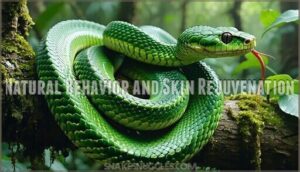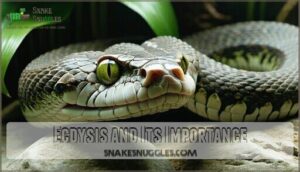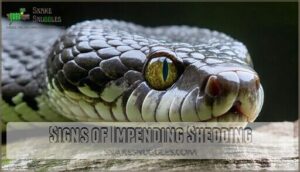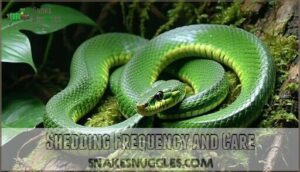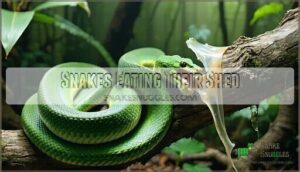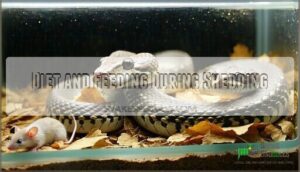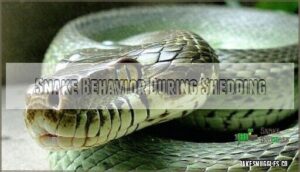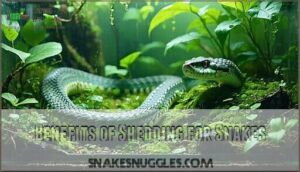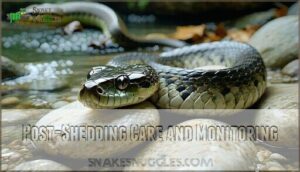This site is supported by our readers. We may earn a commission, at no cost to you, if you purchase through links.
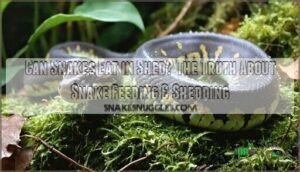
During the pre-shed phase, snakes experience cloudy eyes and dulled skin, making them naturally avoid food for about 7-14 days.
Their vision becomes impaired, and stress levels increase, reducing their appetite substantially.
However, their digestive system remains fully functional throughout the process.
If you offer food and your snake refuses, that’s completely normal behavior – don’t worry about it.
Some snakes might occasionally accept an easy meal during shedding, especially if they’re particularly hungry.
The key is maintaining proper humidity levels around 60-70% to guarantee a smooth shed.
Understanding your snake’s unique shedding patterns reveals fascinating insights about their survival instincts.
Table Of Contents
- Key Takeaways
- Snakes Shedding Process
- Can Snakes Eat in Shed
- Shedding Frequency and Care
- Snakes Eating Their Shed
- Diet and Feeding During Shedding
- Snake Behavior During Shedding
- Benefits of Shedding for Snakes
- Post-Shedding Care and Monitoring
- Frequently Asked Questions (FAQs)
- Can snakes eat while in shed?
- Do snakes eat shed skin?
- Can snakes be handled after shedding?
- How can you help a snake during shedding?
- Does a snake hide during shedding?
- Why do snakes shed a lot?
- Why is my snake not eating in the shed?
- Can I feed ball python in shed?
- How long does snake shedding process typically last?
- What humidity levels help snakes shed properly?
- Conclusion
Key Takeaways
- You don’t need to worry if your snake refuses food during shedding – it’s completely normal behavior since their vision becomes impaired and stress levels increase during this 7-14 day process.
- Their digestive system works fine, but they won’t eat anyway – while snakes can technically digest food during shedding, most naturally avoid eating due to cloudy eyes and discomfort.
- Focus on humidity instead of feeding – maintain 60-70% humidity levels to ensure a smooth shed rather than trying to force food on your stressed snake.
- Wait until after they’ve completely shed to resume normal feeding – your snake’s appetite will return naturally once the process is complete and their vision clears up.
Snakes Shedding Process
Shedding is a natural, essential process where snakes replace their entire skin to support growth and remove parasites.
You’ll notice your snake’s skin becoming dull and eyes turning milky blue as they prepare for this monthly cycle called ecdysis.
Natural Behavior and Skin Rejuvenation
Understanding snake shedding reveals fascinating natural processes your pet experiences.
Skin regeneration through ecdysis serves multiple essential purposes.
This natural vulnerability period requires careful observation as your snake’s camouflage renewal begins.
Snake shedding affects snake eating habits substantially, influencing snake feeding during shed cycles and overall snake behavior throughout ecdysis.
- Your snake becomes temporarily blind with cloudy eyes, creating natural vulnerability during this critical period
- Fresh skin provides superior camouflage renewal, protecting your snake from potential threats in their environment
- Shedding benefits include parasite removal and complete skin regeneration for ideal health and comfort
Ecdysis and Its Importance
Ecdysis, the scientific term for snake shedding, serves multiple essential purposes for your snake’s health.
This process allows snakes to replace old, restrictive skin with fresh, flexible layers that accommodate growth.
Healthy shedding removes parasites, prevents infections, and maintains proper skin regeneration throughout your pet’s life, which are all essential for the snake’s overall health.
Signs of Impending Shedding
Before your snake sheds, watch for telltale snake shedding signs that signal the process is starting.
You’ll notice cloudy eyes and bluish skin as your snake prepares for ecdysis.
During this period, expect hiding behavior and reduced activity as vision impairment makes them vulnerable.
Monitor for skin dullness and increased snake stress responses, as these changes indicate your pet needs extra care during this natural but challenging time.
Can Snakes Eat in Shed
Most snakes won’t eat during their shedding cycle, and that’s perfectly normal behavior you shouldn’t worry about. Your snake’s appetite naturally decreases as their body prepares for this vulnerable time, especially during the "blue-eyed" or milky-eye phase when their vision becomes impaired.
Don’t worry if your snake refuses food during shedding—it’s their natural survival instinct kicking in.
Here’s what you need to know about snake feeding during shedding:
- Feeding refusal is natural – Shedding appetite drops substantially as snakes focus energy on skin renewal
- Milky-eye feeding risks increase – Impaired vision makes live prey dangerous for temporarily blind snakes
- Post-shed hunger returns quickly – Most snakes resume normal feeding within days after completing their shed
- Forced feeding causes stress – Never attempt to make your snake eat during this delicate process
- Preshed feeding is acceptable – Offering food before shedding begins won’t harm your snake
Some individual snakes might accept pre-killed prey during shedding, but don’t be concerned if yours refuses. Captive snakes are often prone to overfeeding issues, so skipping a meal isn’t detrimental. Postshed feeding typically resumes naturally once your snake’s senses return to normal.
Shedding Frequency and Care
Understanding your snake’s shedding patterns helps you provide proper care and recognize potential problems early.
Shedding frequency varies by species and individual factors, ranging from monthly to several times per year, and successful shedding depends on adequate humidity, proper nutrition, and a stress-free environment.
Factors Influencing Shedding Success
Several key factors determine whether your snake sheds successfully.
Humidity levels, temperature, and nutritional intake directly impact snake shedding quality.
Poor habitat quality, dehydration, or stress reduction issues often cause snake shedding problems like dysecdysis.
You’ll need proper hydration levels and adequate nutrition to support snake health.
Previous injury history can also affect how smoothly the process occurs.
Snakes typically undergo skin renewal called ecdysis, a process that’s natural but can present challenges.
The process of snake shedding is influenced by various factors, including humidity levels and nutritional intake.
To ensure a successful shed, it’s essential to provide your snake with a suitable environment and adequate care.
Dysecdysis and Its Consequences
When incomplete shedding strikes, you’ll face serious snake health during shed complications that demand immediate attention.
Dysecdysis creates stuck shed around sensitive areas like eye caps and tail tips, potentially causing blindness or circulation loss requiring amputation.
Dehydration impact worsens scale damage, while infection risk increases with retained skin fragments.
Preventative measures include proper humidity and consulting your snake veterinarian promptly. Maintaining proper enclosure humidity is essential for prevention of such issues, and addressing them promptly is crucial for the snake’s health, especially to prevent serious complications.
Proper Disposal of Shed Skin
After your snake completes the shedding process, you’ll need to remove the old skin from the enclosure promptly to prevent bacterial growth and maintain proper hygiene.
Store the shed skin in a breathable container if you’re keeping it for identification or educational purposes.
Consider specialized disposal options for snake sheds, as safe handling prevents contamination while proper snake skin disposal reduces environmental impact and keratophagy concerns in multi-pet households.
Snakes Eating Their Shed
You’ve probably seen your snake’s shed skin lying around their enclosure and wondered if they’d actually eat it.
While most snakes don’t consume their shed skin, some species do practice autophagy—eating their own shed for nutrient recovery and opportunistic feeding benefits, which can be considered as opportunistic feeding.
Nutrient Recovery and Opportunistic Feeding
When you’re dealing with shed consumption in captivity, opportunistic feeders like king snakes occasionally view their discarded skin as potential food.
While the nutritional value of shed skin remains minimal compared to proper prey, some captive snakes exhibit this wild behavior during stress or hunger.
The digestion impact proves negligible, though monitoring becomes important for snake shedding and nutrition concerns in your pet’s feeding routine.
Autophagy and Its Benefits
While opportunistic feeding explains some shed consumption, autophagy represents a different biological process entirely.
You’ll find autophagy involves cellular self-digestion for nutrient recycling, but this mechanism doesn’t directly relate to snake shedding autophagy or shed skin digestion.
Scientific evidence shows autophagy occurs at the cellular level in snake nutritional needs, yet shed consumption remains rare occurrences with minimal digestive processes benefits despite evolutionary significance.
Exceptions and Rare Cases
While most snakes don’t consume their shed skin, certain circumstances create exceptions to this rule. Unusual diets emerge when captive consumption occurs during stressful situations or first sheds in young snakes.
Proper shedding requires humidity between 50-70% to avoid issues.
There are several reasons why snakes might consume their shed skin, including:
- Stress-induced eating from environmental changes or handling during shedding periods
- Impaired vision causing snakes to mistake shed skin for prey items
- Opportunistic species like king snakes consuming available organic matter including sheds
- Young snakes learning proper shedding behavior may accidentally ingest skin fragments
Diet and Feeding During Shedding
When your snake enters the shedding process, you’ll need to adjust its feeding routine carefully.
Shedding time calls for feeding adjustments—your snake’s comfort comes first during this vulnerable period.
Most snakes naturally refuse food during shedding due to impaired vision and discomfort, but some species may still accept meals depending on their individual behavior.
Live Prey and Its Risks
Feeding live prey during shedding creates serious risks for your snake.
When your snake’s vision becomes cloudy, it can’t accurately strike prey, leading to live prey injuries from defensive bites.
This stress response compromises snake health and raises ethical considerations about humane alternatives.
Live prey also increases parasite transmission risks during this vulnerable period, making proper snake care and snake feeding practices essential for ideal snake health according to any snake vet.
Pre-Killed Prey and Its Advantages
When you’re facing a snake’s temporary blindness during shedding, prekilled prey becomes your safest bet.
This approach eliminates the risk of prey bites while your snake’s senses are compromised.
Key advantages of prekilled prey during shedding:
- Safer Feeding – No risk of prey animals defending themselves against temporarily blind snakes
- Reduced Risks – Eliminates parasite transmission and facial injuries from live prey attacks
- Ethical Concerns – Avoids stress for both predator and prey during vulnerable periods
- Convenient Storage – Frozen options allow flexible timing when snakes show refusal to eat
- Prey Size consistency guarantees proper snake diet without feeding complications
Feeding Schedule and Overfeeding
During your snake’s shedding cycle, you’ll notice appetite naturally declines, making skipped feedings completely normal and harmless.
Experts recommend waiting until post-shed for scheduled meals since healthy captive snakes handle missed feedings well during this vulnerable period.
Your snake’s feeding schedule should accommodate natural shedding patterns.
Captive diets often exceed wild feeding frequency, increasing obesity risks if you don’t adjust portions appropriately.
| Feeding Aspect | Wild Snakes | Captive Snakes |
|---|---|---|
| Feeding Frequency | 10 times yearly | Weekly/bi-weekly |
| Prey Size | Variable availability | Consistent portions |
| Obesity Risks | Rare due to hunting | Common from overfeeding |
| Diet Consistency | Seasonal changes | Regular schedule |
| Nutritional Balance | Natural variation | Controlled nutrition |
Snake Behavior During Shedding
During shedding, you’ll notice your snake becomes less active and may refuse food completely due to discomfort from loosening skin.
This temporary loss of appetite is completely normal, and maintaining proper hydration becomes more critical than feeding during this vulnerable period, which is a key aspect of ensuring your snake’s health during shedding, particularly because discomfort can significantly impact its behavior.
Reduced Appetite and Discomfort
When your snake’s shedding clock starts ticking, appetite reduction becomes their natural response to skin sensitivity and discomfort.
During this vulnerable period, behavioral changes include decreased activity and food refusal as their body prioritizes the shedding process over digestion.
This stress response protects them from potential harm while their vision remains impaired, making eating both difficult and risky for their overall health.
Hydration and Its Importance
Why does proper hydration matter so much during snake shedding? Your snake’s body needs extra water to create the fluid layer between old and new skin.
Watch for dehydration signs like wrinkled skin or lethargy. Maintain proper humidity levels and provide soaking options through clean water bowls.
Water balance is essential for cellular function. Water quality affects drinking behavior, and adequate hydration prevents shedding complications that could impact your snake’s eating patterns.
Behavioral Changes and Stress
During shedding stress, you’ll notice your snake exhibiting reduced activity and increased hiding behavior.
This stress response is natural as impaired vision makes them feel vulnerable. Handling risks increase substantially during this period, so minimize disturbances.
Appetite changes are common, with most snakes refusing food. Creating a stress-free environment with proper humidity supports stress reduction and helps your snake shed successfully.
Benefits of Shedding for Snakes
You’ll discover that shedding isn’t just about getting new skin—it’s a complete health makeover that keeps your snake thriving.
This natural process delivers multiple benefits that directly impact your snake’s survival, comfort, and overall wellbeing.
Parasite Removal and Regeneration
Beyond removing unsightly old skin, ecdysis benefits your snake’s health through natural parasite elimination.
Shedding removes harmful parasites attached to old skin, reducing infection risks while promoting injury recovery.
The process eliminates dirt and surface damage, supporting healthy shedding cycles.
Snake skin regeneration contains compounds that boost immune response and wound healing, making regular parasite removal essential for maintaining ideal snake health in captivity.
Camouflage and Predator Avoidance
Fresh skin serves as nature’s ultimate disguise for your snake.
Newly shed skin appears brighter and more vibrant, dramatically improving shedding camouflage effectiveness in their natural habitat.
The fresh appearance reduces predator visibility by eliminating dull, damaged scales that make snakes stand out.
The chemical camouflage benefits include reduced scent trails, helping with avoiding detection from potential threats, and this is due to the natural habitat and camouflage effectiveness.
Temperature Regulation and Comfort
Maintaining ideal thermal gradients becomes easier with fresh, elastic skin that responds better to temperature changes.
Your snake’s newly shed skin improves basking behavior and thermoregulation, while proper humidity levels and moist hide placement in the enclosure design help reduce snake shedding stress relief through better substrate choice and habitat adjustment, which ultimately aids in thermoregulation.
Post-Shedding Care and Monitoring
Once your snake finishes shedding, you’ll want to remove any leftover skin pieces from the enclosure to prevent bacterial growth and maintain hygiene.
Keep an eye on your snake for the next few days, watching for any signs of digestive upset if they happened to eat their shed, and don’t hesitate to contact your veterinarian if you notice unusual behavior or health concerns.
Removing Uneaten Shed Skin
After your snake completes its shedding process, you’ll need to handle the leftover skin properly. Uneaten shed skin can quickly become a breeding ground for harmful bacteria, creating hygiene concerns in your pet’s environment.
Here’s your post-shedding checklist:
- Remove shed skin within 24-48 hours to prevent bacterial growth
- Use gloves or tongs for proper handling and safe disposal
- Check all hiding spots where pieces might remain stuck
- Clean the enclosure with reptile-safe disinfectant as preventative measures
- Store removed sheds in breathable containers if keeping for records
Don’t let old skin linger in the habitat. Consider safe disposal options for the shed skin. Even small fragments can harbor bacteria and create snake shedding complications that affect your pet’s health.
Monitoring for Digestive Issues
After your snake consumes shed skin, watch for digestive signs that indicate potential stomach trouble. Most snakes handle shed consumption without issues, but bacterial growth from old skin can occasionally cause problems.
| Normal Signs | Warning Signs | Action Needed |
|---|---|---|
| Regular movement | Lethargy for 48+ hours | Monitor closely |
| Normal defecation | No bowel movement 7+ days | Vet consultation |
| Active behavior | Repeated vomiting | Immediate vet care |
| Eating normally | Refusing food 2+ weeks | Professional exam |
| Clear eyes/skin | Unusual swelling | Emergency visit |
Post-shedding monitoring involves observing your snake’s behavior patterns for several days. Snake digestive issues from shed consumption typically appear within 24-48 hours. Look for changes in activity levels, bathroom habits, and appetite. Snake behavior monitoring during this period helps identify any stomach trouble early, ensuring your pet’s health remains prime.
Consulting a Vet for Concerns
If you notice shedding problems or odd behavior after feeding, don’t hesitate to seek vet expertise.
Preventative care and health monitoring are key for snake shedding and overall snake health.
A snake veterinarian can offer expert advice and veterinary consultation, helping you catch issues early.
When in doubt, professional input is your best bet for safe, confident snake feeding.
Frequently Asked Questions (FAQs)
Can snakes eat while in shed?
Yes, you can feed snakes during shedding, though most won’t eat. Some species with milky eyes still accept food, while others refuse until shedding completes. It’s safe either way.
Do snakes eat shed skin?
Surprisingly, only about 15% of snake species actually eat their shed skin regularly.
You’ll find that most snakes don’t consume their sheds, but opportunistic feeders like king snakes sometimes do for minimal nutritional benefits.
Can snakes be handled after shedding?
Yes, you can handle most snakes after shedding, but wait until they’ve fully completed the process. Fresh post-shed snakes may feel more sensitive, so gentle handling works best initially.
How can you help a snake during shedding?
Like a caring parent creating a safe nursery, you’ll want to provide ideal conditions for your shedding snake.
Increase humidity to 60-70%, make certain fresh water‘s available, and avoid handling during this vulnerable time when their vision’s clouded.
This will help ensure your snake has the best environment to shed safely.
Does a snake hide during shedding?
Yes, snakes typically hide during shedding because their vision becomes impaired from cloudy eyes and milky skin.
This temporary blindness makes them vulnerable to predators, so they instinctively seek secure hiding spots until the process completes, which is driven by their natural instinct for survival.
Why do snakes shed a lot?
Though you might think snakes shed constantly, they actually shed just 4-12 times yearly.
You’re witnessing normal growth cycles – snakes can’t stretch their skin like you can, so they must completely replace it to accommodate their growing bodies, which is a result of their normal growth and the need for complete replacement of skin.
Why is my snake not eating in the shed?
Your snake isn’t eating during shedding because it’s completely normal behavior.
Snakes typically refuse food when shedding due to discomfort, reduced vision, and natural instincts to fast during this vulnerable period.
Can I feed ball python in shed?
Absolutely not recommended!
Feeding your ball python during shed is like offering dinner to someone wearing a blindfold.
During shedding, your snake’s vision becomes impaired with milky eyes, making feeding potentially dangerous.
They typically refuse food anyway, so skip feeding until the process completes.
How long does snake shedding process typically last?
The snake shedding process typically lasts 7-14 days from start to finish.
You’ll notice pre-shed signs like cloudy eyes for several days, then the actual skin removal happens within 24-48 hours once it begins.
What humidity levels help snakes shed properly?
Proper humidity helps your snake’s shedding succeed smoothly.
You’ll want 60-80% humidity during shedding periods, which is higher than normal levels.
This moisture softens the old skin, making removal easier and preventing stuck shed pieces that could cause problems, ensuring your snake’s shedding process is as smooth as possible.
Conclusion
Understanding whether can snakes eat in shed becomes absolutely vital for every reptile owner’s success.
You’ve learned that snakes typically refuse food during their 7-14 day shedding period due to impaired vision and increased stress levels.
While their digestive systems remain functional, most snakes won’t accept meals until they’ve completed their shed.
Remember to maintain proper humidity levels and don’t force feeding during this natural process – your snake knows best.
- https://huskiecommons.lib.niu.edu/studentengagement-honorscapstones/1158/
- https://arachnoboards.com/threads/is-it-bad-to-feed-your-snake-when-its-about-to-shed.129757/
- https://community.morphmarket.com/t/normal-for-ball-python-to-stop-eating-before-shed/43088
- https://www.livescience.com/animals/snakes/why-do-snakes-shed-their-skin
- https://www.reddit.com/r/reptiles/comments/1ccly3u/snake_ate_its_shed/

